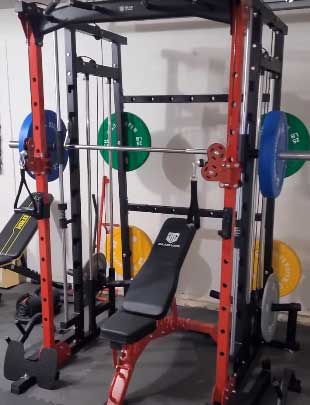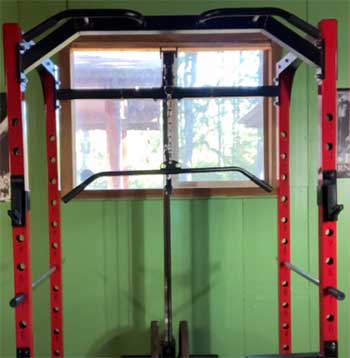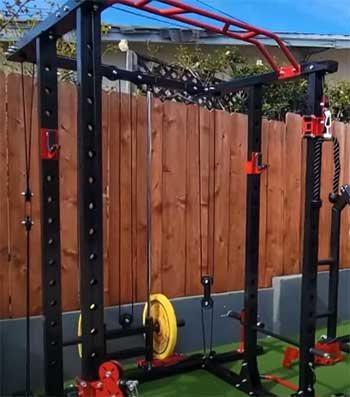As home gyms continue to grow in popularity, more and more fitness enthusiasts are looking to outfit their personal workout spaces with versatile equipment that can help them meet a variety of strength training goals.
Two power rack options that frequently top home gymmers’ shopping lists are the MAJOR LUTIE power rack and the Mikolo fitness power rack. But with two high-quality racks touting similar features to choose between, making the right selection for your space and budget can pose a tricky balancing act.
Below, we’ll break down the key similarities and differences between these two popular home gym power racks across a range of factors. Read on for the intel you’ll need to decide which heavy-duty rack reigns supreme for your strength training setup.
A Brief Comparison Table
| Feature | MAJOR LUTIE | Mikolo |
| Price | $369 | $499 |
| Weight Capacity | 700 lbs | 800 lbs |
| Height Adjustment Range | 83 – 93 inches | 83.8 – 92.5 inches |
| Dip Bars | Adjustable handles extending from rear of rack | Fixed parallel bars centered inside rack |
| Pull-up Bar | Straight bar attachment spanning rack width | Multi-grip pull-up station inside rack |
| Other Attachments | Adjustable J-hooks, band pegs, storage pegs | Fixed J-hooks only |
| Assembly Time | 1-2 hours | 30 minutes |
| Available Colors | Black, Gray, Black/Gray | Black only |
Overview and Key Specs
Before diving into the nitty gritty details, let’s first take a look at some key specs for each rack:
MAJOR LUTIE Power Rack

- Height: 83 – 93 inches
- Width: 47 inches
- Depth: 47 inches
- Weight capacity: 700 pounds
- Adjustable safety bars and J-hooks
- Dip attachment and pull-up bar
Mikolo Fitness Power Rack
- Height: 83.8 – 92.5 inches
- Width: 49.2 inches
- Depth: 47.6 inches
- Weight capacity: 800 pounds
- Adjustable safety bars and J-hooks
- Dip handles and multi-grip pull-up bar
With such similar dimensions and weight capacities exceeding 700 pounds, both the MAJOR LUTIE and Mikolo rack stand as exceptionally sturdy picks appropriate for most home gym spaces and users’ strength levels.
And with comparable adjustment ranges topping out above 90 inches, each unit provides ample overhead room for exercises like overhead presses for taller athletes.
Outside the basic specs, however, a few key differences start emerging—particularly when it comes to available attachments and accessories. Read on as we explore how these and other factors stack up in a head-to-head comparison.
Key Differences Between MAJOR LUTIE And Mikolo Power Rack
- Footprint and Floor Space Usage
Given their nearly identical depths and widths falling within a few inches of 4 feet by 4 feet, the MAJOR LUTIE and Mikolo occupy roughly the same floor area.
Both racks also feature a similar style of base with two sets of feet extending in both directions. So you’re working with the same stable but sizable footprint for each model.
If maximizing open floor space is a top priority or you’re working with tight quarters, pay attention to accessory placement. The Mikolo rack attaches its dip handles and pull-up bar within the main frame, while MAJOR LUTIE’s dip handles and multi-grip pull-up bar extend about another foot out the back of the unit.
However, some users really like having that extra space to move between the main rack uprights and the rear accessory pull-up bar. So whether the few inches of difference here makes or breaks the functionality depends on just how cramped your current space feels.
- Adjustability

No good home power rack comes without ample adjustment settings—and neither model disappoints in this category.
Both the MAJOR LUTIE and Mikolo racks allow you to set the crossbar spotter arms at 1-inch increments up and down the upright columns.
Giving users’ adequate customization to fine-tune the safeties and hooks to best accommodate their exercises and body height.
The Mikolo does offer slightly more height adjustment with about 9 extra inches of extension on the upper end.
But both setups still provide enough variation for most users—from a 5-footer to well over 6 feet tall.
One small adjustability difference does arise on the J-hooks and additional accessory attachments. The Mikolo fitness power rack ships with fixed J-hooks and a multi-grip pull-up bar that both attach at a single height.
Meanwhile, MAJOR LUTIE’s J-hooksSlide into place anywhere along the uprights and its dip bars even adjust outward at angles to work for different body types. So while Mikolo wins for squat safety arm adjustment range, MAJOR LUTIE takes the edge for more versatile accessory positioning.
- Weight Capacity and Stability
Staking a claim as true powerhouse pieces of home gym equipment, both the Mikolo and MAJOR LUTIE boast impressively high weight capacities clearing 700+ pounds. The MAJOR LUTIE maxes out at 700 even, providing plenty of room even for seasoned powerlifters piling substantial weight onto the bar.
The Mikolo then just barely bests its competition’s limit with an 800-pound capacity—but that 100-pound difference comes with a negligible advantage for most home gym users.
Both racks also appear strikingly stable and shake-free based on user reviews thanks to their heavy steel and metal construction. The adjustable feet helping ensure each unit sits planted firmly into your flooring.
Overall, it’s essentially a wash when it comes to capabilities handling hundreds of pounds of weight safely and with confidence.
- Attachment and Accessories
As lightly touched on earlier, the Mikolo and MAJOR LUTIE take somewhat different approaches when it comes to attachments and accessories for enhancing your workouts.
Mikolo concentrates its dip bars and multi-grip pull-up station centrally within the main cage frame. Meanwhile, MAJOR LUTIE separates its dip handles off the back end and adds a straight pull-up bar spanning the top.
For some home gym owners, the choice may simply come down to setup convenience and personal accessory preference. But let’s dive a little deeper into how these design differences could sway your purchasing picks:
Dip Bars
- Mikolo: Fixed parallel dip bars centered inside the rack
- MAJOR LUTIE: Adjustable standalone dip handles off back
Mikolo’s built-in dip bars feature a stationary open spacing, but some shorter or less mobile users may find it tricky positioning themselves between the close-set handles. MAJOR LUTIE’s handles adjust outward to better accommodate different body types—a definite position for accessibility.
Pull-up Bars
- Mikolo: Multi-grip pull-up station inside rack
- MAJOR LUTIE: Straight bar attachment across rear top
Fans of neutral and chin-up grips may appreciate Mikolo’s variety of mixed handles for hitting their back muscles from different angles. But the centered placement could feel restrictive for kipping movements compared to MAJOR LUTIE’s more rearward straight bar with open space.
- Other Attachments
A final difference comes down to additional attachments available beyond the basics. MAJOR LUTIE notably provides J-hooks, adjustable band pegs, resistance band anchor points, and extra storage pegs for adding further functionality down the line.
Meanwhile, Mikolo currently only ships with one fixed set of J-hooks limiting flexibility adding new accessories.
- Assembly and Instructions
Putting together a power rack generally ranks among the more complex gym equipment assembly jobs—especially for first-timers. Multiple heavy frame pieces plus fiddly fasteners that enable all those micro adjustment settings can quickly overwhelm.
Fortunately, both Mikolo and MAJOR LUTIE earn praise for smoothing out this potentially frustrating process.
The Mikolo fitness power rack arrives as a near-complete single unit with its uprights, cross members and pull-up bar all pre-installed. You’ll spend most of your assembly time only securing individual joints and attachments.
Reviewers report putting the full unit together solo in as little as 30 minutes thanks to the simplified process.
MAJOR LUTIE takes just slightly more work because you connect the upright posts and overhead crossbars yourself during the initial construction.
But the rack still earns consistent positive feedback for straightforward instructions and an intuitive building method almost anyone can handle independently in around 1-2 hours. Plus MAJOR LUTIE offers helpful instructional videos breaking down each section if any sections still feel unclear.
For most buyers competent using basic tools, neither rack should pose major headaches to start shaping up your home gym. But the Mikolo holds a narrow advantage on absolute assembly ease and speed.
- Available Colors

Sometimes overlooked, color choice plays a subtle role in integrating racks into existing home gym decor or overall visual appeal.
When it comes to palette, both MAJOR LUTIE and Mikolo play it relatively neutral and safe.
The Mikolo rack comes in a sleek all-black finish that disappearing seamlessly into dark corner spots or complements other equipment finishes like bumper plates.
Meanwhile, MAJOR LUTIE offers three subtle tone options: a two-tone black and gray combo, all gray, or all black.
So while Mikolo may win on styling for some spaces, MAJOR LUTIE still provides pleasing and flexible colorways to suit multiple preferences.
- Price and Value
With high weight limits clearing 700+ pounds, ample adjustments, and secure builds, both the Mikolo and MAJOR LUTIE rack deliver exceptional performance and versatility compared to their price tags.
The Mikolo hits a pleasing sub-$500 price point that squeezes an impressive range of features into a budget-friendly equipment option for savvy shoppers.
But MAJOR LUTIE manages to slightly undercut even Mikolo’s price coming in at just $369. When scoring strictly on value, that sub-$400 ticket combined with MAJOR LUTIE’s abundant add-ons like the adjustable dip handles and band pegs provide one of the top values you’ll find in a home power rack class.
Of course, everyone’s budgets and willingness to spend differ. But if extracting maximum bang from your buck stands among your top considerations, MAJOR LUTIE holds the advantage for offering the most complete and flexible rack package per dollar.
FAQ: Common Power Rack Questions
Foldable power racks can provide solid temporary solutions or make storage simpler in tight spaces. Many fold-up racks offer respectable weight capacities and feature intrinsic portability letting you relocate them easily.
However, lower-end folding racks often compromise long-term durability, wobble more, or lack convenience features of premium commercial-style racks. So folding units work best for travel, limited budgets or secondary spaces rather than acting as a permanent fully-loaded rack.
Investing a few hundred more in a heavy-duty stationary rack pays dividends for stability, safety and versatility accommodating progressive overload.
Power racks and Smith machines serve different primary functions for resistance training. Power racks act as open “cages” for protecting users during compound barbell lifts like squats or bench presses where you stabilize the load yourself. Meanwhile, Smith machines guide barbells along set tracks, reducing degrees of freedom while forcing stricter movement patterns.
Power racks maximize free weight training adapting to make each rep match your body’s genuine strength curves. But Smith machines isolate muscles more uniformly by aligning your pushing and pulling path each rep. Both trainers have pros and cons for building strength or working targeted regions. Blending rack, Smith and free weight exercises lets you leverage their unique benefits.
For dedicated lifters who squat often, a quality squat rack can provide huge value enhancing this essential movement. Squat-optimized racks position adjustable spotter arms specifically to catch failed reps safely above your lowest position. Other perks like band pegs, wheels for micro-loading plates stepped progression and open walk-in access also bolster proper squatting practice.
Before purchasing any specialty rack, first consider your training habits and goals. Casual fitness buffs or garage gym owners on tighter budgets may find sufficient capability from a standard power rack pulling triple duty for squats, bench presses and military presses. But squat-centric athletes will appreciate the tailored assist a dedicated squat rack lends towards excelling this foundational movement.
Power racks and squat racks share similar functionality as adjustable stand-alone lifting stations, but several small differences affect their workout versatility. Squat racks consist only of an open rack frame with adjustable arms, catering specifically to squatting-focused training. Meanwhile, fully-enclosed power racks add built-in pull-up bars, band pegs and four enclosing sides for increased exercise options like chin-ups or bench presses inside the protected “cage” zone.
For smaller home gyms prioritizing squats and overhead presses, compact squat racks maximize valuable floor space. But well-rounded home gyms and garage gyms benefit from full power racks offering “all-in-one” frames for conveniently performing more exercise varieties without needing additional equipment. So choose based on the diversity of movements you plan to perform with the equipment.
The Verdict: MAJOR LUTIE Pulls Off A Close Win
In a head-to-head matchup filled with close calls in categories like footprint, weight limits and stability, the MAJOR LUTIE power rack just manages to squeak by with a hard-fought victory over Mikolo’s impressive challenger rack.
MAJOR LUTIE’s combination of adjustable dip handles and multi-positioning pull-up and band attachments provide that extra element of customization to fine-tune the unit perfectly to your space and body dimensions.
And delivering similar core performance specs to Mikolo at over $100 less, this expertly designed rack should catch the eye of savvy home gym shoppers focused on both value and versatility.
However, casual lifters or anyone simply needing a basic neighborhood of $500 squat stand could also thrive with Mikolo’s simpler out-of-box setup. So while MAJOR LUTIE claims the narrow win, both these racks stand well-equipped handling the demands of most home strength trainers.
